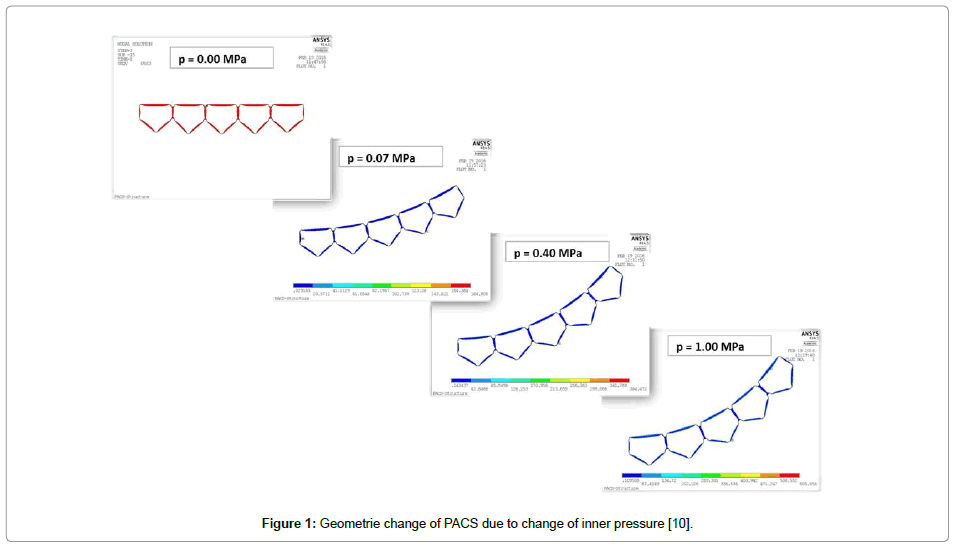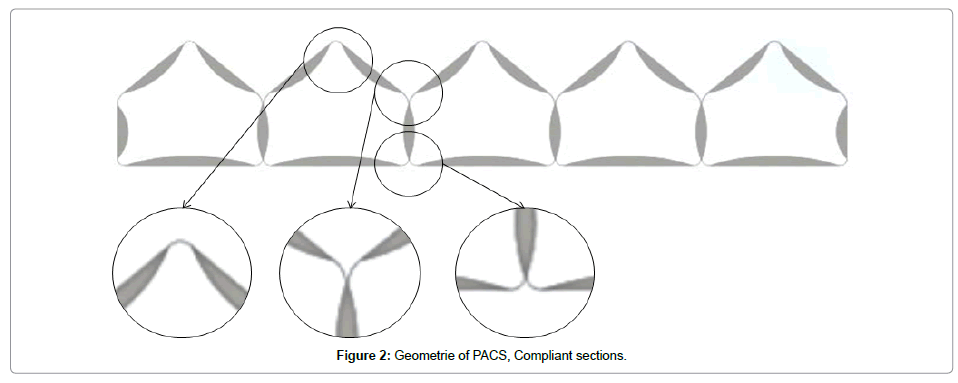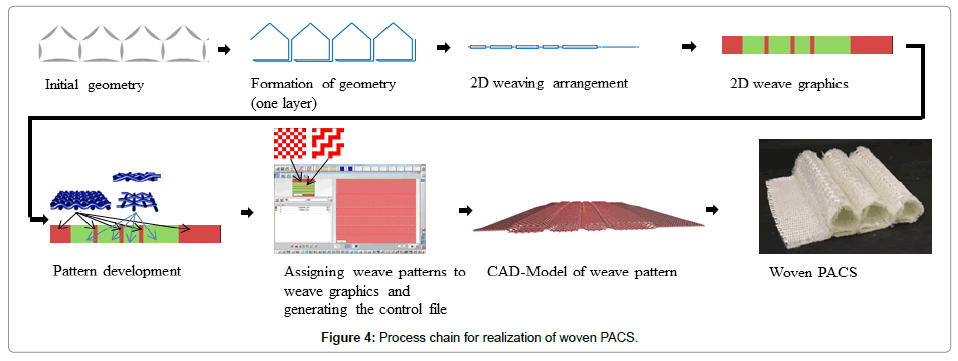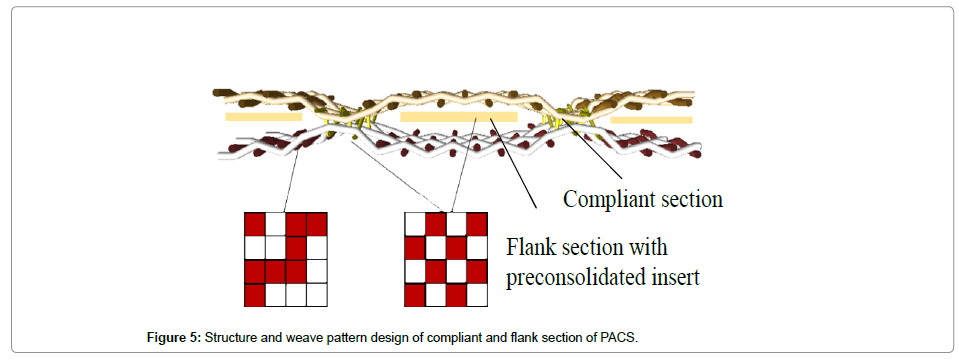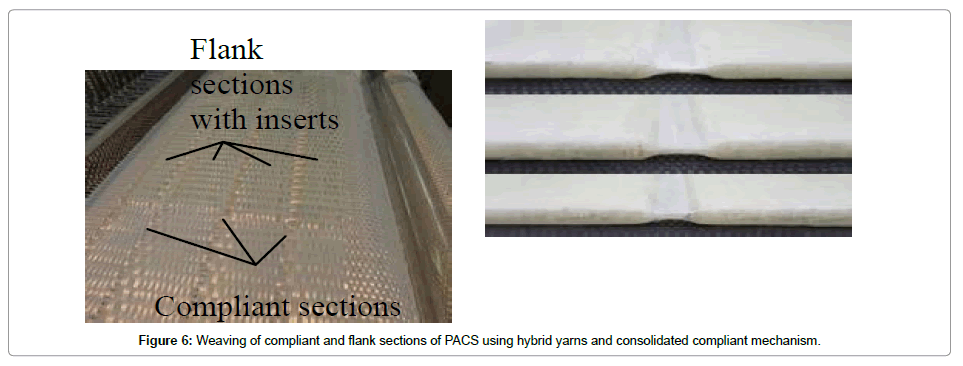Research Article, J Fashion Technol Textile Eng S Vol: 0 Issue: 5
Overview of Necessary Development Steps for the Realization of Woven Cellular Structures for Adaptive Composites
Cornelia Sennewald*, Michael Vorhof, Gerald Hoffmann and Chokri Cherif
Technische Universität Dresden, Faculty of Mechanical Science and Engineering, Institute of Textile Machinery and High Performance Material Technology, D-01062 Dresden, Germany
*Corresponding Author : Cornelia Sennewald
Technische Universität Dresden, Faculty of Mechanical Science and Engineering, Institute of Textile Machinery and High Performance Material Technology, D-01062 Dresden, Germany
Tel: +49 351 463-39938
Fax: +49 351 463-34026
E-mail: cornelia.sennewald@tu-dresden.de
Received: August 08, 2018 Accepted: September 20, 2018 Published: September 25, 2018
Citation: Sennewald C, Vorhof M, Hoffmann G, Cherif C (2018) Overview of Necessary Development Steps for the Realization of Woven Cellular Structures for Adaptive Composites. J Fashion Technol Textile Eng S5:001. doi:10.4172/2329-9568.S5-001
Abstract
Flexible adaptive structures made from fiber-reinforced plastic composites (FRP) with defined stiffness and flexibility have repeatedly aroused the interest of international research groups in the past. The motivation for the development of such structures is to increase efficiency, save weight, extend the existing limits of
structure and tool design and integrate functions. One approach to avoid the contradiction of implementing structural flexibility on the one hand and stiffness, on the other hand, are pressure-actuated cellular structures (PACS), which have so far only been investigated theoretically. Weaving technology offers outstanding approaches to the implementation of such complex 3D geometries. However, there is a lack of methods for the formation of complex 3D geometries such as PACS and for the technical implementation in weaving processes. The aim of this paper is to describe theoretical and experimental knowledge as well as necessary development steps for the realization of woven PACs. The theoretical possibilities for the technical weaving of PACS with necessary large gradients in wall
thickness are determined. A methodology for the weaving of cellular structures composed of individual sections as well as a process chain for geometry processing and pattern development for PACS is introduced. The implementation of the PACS is demonstrated by means of a woven example.
Keywords: 3D weaving; Adaptive structures; Adaptive composites; Compliant structures; Weaving; Hybrid material; Cellular structures; Spacer fabric
Introduction
The use of fiber-reinforced plastics (FRP) is constantly increasing. Textile structures (e.g. 2D weaves, stitch-bonded fabrics) are primarily used as reinforcement structures. A current approach to increasing the economic efficiency of fiber-reinforced plastics is direct preforming. In contrast to sequential preforming, where the final geometry of a component is realized from partial surfaces and cuts of a flat textile, the final geometry of the component is already realized during the manufacturing process in direct preforming. Textile technology, and in particular weaving technology, offers the possibility of realizing highly complex preforms [1-7].
In addition to the geometry and the mechanical load capacity, the functionality of the FRP is playing an increasingly important role for many applications. Adaptive structures in particular have moved into the focus of science. Adaptive structures can adapt to different operating conditions and change their shape, for example. One example inspired by nature is so-called pressure actuated cellular structures (PACS). They use the principle of the Venus fly trap, whereby a change in shape is caused by a change in the internal pressure of the cells. If the transfer of such natural mechanisms into technical systems succeeds, a multitude of application possibilities arise.
The motivation for the development of such structures is to increase efficiency, save weight, extend the existing limits of structure and tool design and integrate functions. In the aerospace sector, the development goals include increased agility and increased aerodynamic efficiency. Despite the high potential of adaptive structures, the advantages of flexible structures are often outweighed by additional peripheral or system-inherent efforts. Adaptive structures can only be realized with conventional methods using complex systems with complicated mechanics and drive technology.
One approach to avoid the contradiction of implementing structural flexibility on the one hand and stiffness on the other hand within the same structure are systems using structure-inherent compliance instead of mechanical joints and external drives. Pressure-actuated cellular structures (PACS-cf) (Figure 1) are adaptive structures, generated through geometric design and locally structure-integrated flexibility (wall thicknesses and differences in stiffness), but have so far only been investigated theoretically [8-11].
Figure 1: Geometrie change of PACS due to change of inner pressure [10].
The aim of this project is to gain theoretical and experimental knowledge which is necessary for the design, production and testing of integral woven PACS made of FRP as well as to determine the theoretical possibilities for the technical weaving of structures with very large gradients in wall thickness.
There are only initial approaches to implementing such complex structures in textile technology. Using the principle of terry weaving, structures with different fabric lengths can be realized. Spacer weaving is a technology developed for the production of spacer fabrics with woven cross-sections, whereby constant lengths are realized in the spacer surfaces in the production direction. However, these technical possibilities have not been combined yet. Curved spacer fabrics, which are necessary for the realization of PACs, are not yet known. In addition, only terry weaves and spacer fabrics with constant wall thicknesses can be produced up to now [12-15].
There is a lack of basic knowledge on geometry formation and the transfer of geometry into a weavable structure. In particular, the realization of large wall thickness gradients for the realization of structure-integrated compliance and the development of a suitable weaving process for the practical realization of PACS represents a major scientific challenge.
Materials, Methods and Procedures
Development of algorithms for geometric mapping of cellular structures
The functionality of the PACS results from the targeted combination of rigid areas (cell sides with high wall thickness) with flexible areas (compliant sections with low wall thickness). The cellular structures are subjected to an internal pressure (pneumatic), which causes the PACS to deform. The deformation is adjustable by the internal pressure. Hence the PACS are adaptive structures. In order to guarantee the functionality of the PACS, the cellular structures must have a defined geometry. A unit cell consists of a pentagon, whereby the PACS are composed of several unit cells. For a textile-technical implementation of the PACS, it must also be taken into account that the PACS have inhomogeneous wall thicknesses. In concrete terms, differences in wall thickness in a ratio of 1:12 have to be achieved. The thin areas are so-called compliant sections. The thicker sides form the cell sides. The differences in wall thickness result in different stiffness in the individual areas, resulting in compliance in the flexible area. For the functionality of the PACS, the defined spatial arrangement of cell sides and compliant sections is required (Figure 2).
For the weaving of the PACS the geometry has to be formed by fabric layers. For this purpose, an algorithm was developed that composes the geometry of the PACS from partial surfaces. For this purpose, the unit cell is broken down into elements (cf. Figure 3). The number of fabric layers from which the PACS are to be assembled is defined in a next step. Using the algorithm, the individual elements are then combined with the number of fabric layers to form PACS. This results in all solutions for the geometric formation of the PACS by partial surfaces. Figure 3 (right) shows selected examples of the geometry formation of the PACS through 1 to 4 fabric layers.
The developed solutions are evaluated with regard to their suitability for the implementation of the PACS. The evaluation criteria used for this result from the usage requirements of the PACS. For example, to achieve the mechanical properties, a continuous fiber arrangement is required in the compliant sections. In addition to the formation of geometry by partial surfaces, it is also imperative that the PACS are composed of cell sides and compliant sections. For this purpose, individual technical textile solutions were developed for the individual areas. Weave patterns for the compliant sections and for the cell sides were developed and combined to form the overall structure, taking into account the formation of geometry.
Weave structure development for individual sections of the cellular structure
A special challenge in weaving the PACS is the realization of the large gradients in the wall thicknesses. In concrete terms, a ratio of 1:12 is to be achieved, whereby the composite thickness in the compliant section should be only 0.3 mm, resulting in a thickness of 3.6 mm for the cell sides. In order to minimize the development effort, weaving solutions have been developed for each sub-area. The compliant sections can be designed as single-ply fabric in different weaves (plain, twill, satin), as leno fabric or only with warp reinforcement. In addition, a wide variety of materials can be specifically combined with each other. Depending on the materials used, suitable weaving parameters were identified and single-layer fabrics were produced and thermo-pressed into fiber composite structures. Since no cutting processes are to be used, weaving with inserts is to be preferred for the practical realization of the cell sides of the PACS. The inserts are made of the same type of material. For this purpose, individual layers of fabric are arranged one above the other and pressed according to consolidation parameters. These composite panels are then assembled in accordance with the geometric requirements and made available for the weaving process.
Methodology for weaving of cellular structures composed of individual sections and development of a process chain for geometry processing and pattern development for PACS
Based on the determined layer arrangements, the PACS must be processed into the 2D level for weaving. In accordance with the geometry, dimensions and arrangement of cell sides and joint areas, the individual fabric layers must in turn be subdivided. With two or more fabric layers, the PACS are realized in a pleat or spacer weaving process. As a result, float areas must inevitably be integrated. In the area of floats, the excess lengths are then retracted during the manufacturing process and the fabrics are set up.
To implement the PACS for weaving, a process chain (Figure 4) was developed which generates a complete weave pattern based on the formation of the geometry. As already described, the geometry is formed by fabric partial surfaces, which are then unwound into the plane. In addition, the compliant sections and cell sides are integrated within these partial surfaces. The development of the partial surfaces into the plane results in a multi-layer structure with individual fabrics and float areas. This 2D weaving arrangement is converted into a 2D weave graphic.
The 2D weave graphic displays the individual subareas as colored areas. According to the previous development in pattern technology for the sub-areas of compliant sections and cell side, we develop weave patterns for the sub-areas of weaving arrangement. The total weave pattern of the PACS is created by assigning the individual patterns to the color areas of the 2D weave graphic.
Since the PACS are lightweight structures, they are to be designed as fiber-reinforced plastic composites. The reinforcement layer is made of glass fiber. The matrix material is made of thermoplastic material. Hybrid yarns are used to ensure an even distribution of the matrix material.
Two different hybrid yarn materials are used for the development of cellular 3D structures. For reliable processing of hybrid yarns in the weaving process, it is necessary either to twist or pre-consolidate the hybrid yarns. This is the basis for the selection and development of the yarns. The first hybrid yarn was produced with a yarn count of 900 tex, consisting of glass fiber 2 × 300 tex (GF, 67% by weight, 46% by volume) and polyamide 1 × 300 tex (PA, 33% by weight, 54% by volume) with 20 turns per meter. Twisting densifies the yarn surface to ensure optimum yarn processing during the weaving process. Another material used is TecTape with a yarn count of 1800 tex, consisting of glass fiber (GF, 67% by weight, 46% by volume) and polyamide (PA, 33% by weight, 54% by volume). TecTape consists of pre-consolidated spread multifilament yarns, with 2 × Pa with 300 tex on the outside and GF multifilament with 1200 tex in the middle. TecTape has a tape shape with a width of 6-8 mm and a thickness of 0.2 mm and is therefore predestined for the production of very thin fabrics.
Results and Discussion
Weave trials for individual sections
Based on the developments for the sub-areas, the solutions were combined to meet the requirements and realized using the example of a single compliant section. An example compliant section and the corresponding weave patterns are shown in Figure 5. The single compliant sections consist of a single-layer plain weave in the compliant section and a two-layer fabric in the cell side area as well as an insert integrated in the weaving process consisting of pre-consolidated fabric.
The practical realization of a compliant section in the weaving process allows the proof of the processability of the hybrid yarns. Furthermore, it can be shown that a wall thickness gradient of 1:12 can be achieved through the weaving integration of inserts. Compliant sections of different configurations were woven and subsequently consolidated. Wall thicknesses of 0.3 mm in the compliant section and 3.6 mm in the cell side area were achieved. There is a complete consolidation without blowholes. Figure 6 shows exemplary woven compliant sections and consolidated compliant sections with different radii between compliant section and flank section (cell side).
Weave trials for PACS composed of one woven layer
For the practical realization of the PACS from a single woven layer, the developed weave pattern is woven on a rapier weaving machine. Pre-consolidated inserts are integrated in the two-layer structure. The parameters of the woven structure are given in Table 1.
First the entire length is woven, then the fabric layers of the twolayer fabric are separated on the machine side by bringing the warp threads of the upper fabric into the high shed position and the warp threads of the lower fabric into the low shed position. The insert is then inserted into the resulting woven pocket. To form the PACS from a single fabric part surface (Figure 7), the woven layer has to be fold according to the determined arrangement.
Conclusion
The use of textile reinforced composites in automotive, mechanical and plant engineering sectors is steadily increasing. This is accompanied by an increasing demand for load-adapted, highly flexible and variable structures. In particular, the formation of adaptive structures (variability in form) through selective geometric design in combination with compliant mechanisms shows very great potential for fulfilling the complex requirements. Weaving technology offers outstanding approaches to the implementation of complex 3D geometries. However, there is a lack of methods for the formation of complex 3D geometries such as PACS and for the technical implementation in weaving processes. Therefore, algorithms and methods for the formation of geometry were developed for the realization of PACS by means of weaving. The knowledge gained in the field of geometry formation for the specific arrangement and connection of fabric layers has a generally valid character and can be applied to other 3D geometries. The process chain developed for weaving implementation, i.e., the transfer of layer arrangement into a 2D weaving arrangement and the creation of weave patterns by assigning individual patterns to a 2D weave graphic; can also be used for the realization of complex 3D structures in a weaving process. Weave structures have been developed and implemented for the individual sub-areas of PACS. Through performing weave trials for PACS composed of one woven layer the feasibility of the developed process chain is shown. The results obtained serve as a basis for the development of a technology concept and for the constructional and technological work for the development of a weaving machine concept for the realization of the PACS composed of two and more layers.
Acknowledgment
The authors would like to thank the German Research Foundation (DFG) for the financial support for the project (DFG CH 174-42-1).
References
- Cherif Ch (2015) Textile material for lightweight constructions, Springer, Berlin
- Bannister M (2001) Challenges for composites into the next millennium – a reinforcement perspective. Compos Part A Appl Sci Manuf 32: 901-910.
- Cherif Ch, Krzywinski S, Diestel O, Schulz C, Lin H, et al. (2012) Development of a process chain for the realization of multilayer weft knitted fabrics showing complex 2D/3D geometries for composite applications. Text Res J 82: 1195-1210.
- McHugh C (2014) Carbon fibre textiles and textile structures for light- weight fibre reinforced composites.
- Islam A (2012) 3D woven structures and an overview of manufacturing technologies. Proceedings of 4th World Conference on 3D Fabrics and their Applications, Aachen, Germany.
- Khokar N (2011) Aligning 3D Fabric-forming processes with market requirements. proceedings of the third world conference on 3d fabrics and their applications, Wuhan, China
- Sharpa K, Bogdanovich B, Boylec R, Browna J, Mungalov D (2013) Wind blade joints based on non-crimp 3D orthogonal woven Pi shaped preforms. Composites Part A 49: 9-17.
- Khokar N (2014) Development of innovative 2d and 3d fabric-forming processes for manufacturing composite reinforcements. proceedings of the 8th aachen-dresden international textile conference, Dresden, Germany.
- Karahan M, Gül H, Ivens J (2012) Low Velocity Impact Characteristic of 3D Integrated Core Sandwich Composites. Text Res J 82: 945-962.
- Gramüller B et al. (2014) PACS - Realization of an adaptive concept using pressure actuated cellular structures. Smart Mater Struct 23: 115006.
- Gramüller, B, Köke H, Hühne CH (2015) Holistic design and implementation of pressure actuated cellular structures. Smart Mater Struct 24: 125027.
- Mountasir A, Hoffmann G, Cherif CH, Löser M, Grobmann K (2015) Competitive manufacturing of 3D thermoplastic composite panels based on multi-layered woven structures for lightweight engineering. Compos Struct 133: 415-424.
- Mountasir A, Michael, Gerald H, Chokri C, Grobmann K (2016) 3D woven near net shape preforms for composite structures. Adv Eng Mater 18: 391-396.
- Xiaogang C, Taylor LW, Tsai LJ (2011) An overview on fabrication of three-dimensional woven textile preforms for composites. Text Res J 81.9: 932-944.
- Xiaogang C, Sun Y, Gong X (2008) Design, manufacture, and experimental analysis of 3D honeycomb textile composites Part I: design and manufacture. Text Res J 78: 771-781.
 Spanish
Spanish  Chinese
Chinese  Russian
Russian  German
German  French
French  Japanese
Japanese  Portuguese
Portuguese  Hindi
Hindi 